Antonio Torralba
OPENTOUCH: Bringing Full-Hand Touch to Real-World Interaction
Dec 18, 2025Abstract:The human hand is our primary interface to the physical world, yet egocentric perception rarely knows when, where, or how forcefully it makes contact. Robust wearable tactile sensors are scarce, and no existing in-the-wild datasets align first-person video with full-hand touch. To bridge the gap between visual perception and physical interaction, we present OpenTouch, the first in-the-wild egocentric full-hand tactile dataset, containing 5.1 hours of synchronized video-touch-pose data and 2,900 curated clips with detailed text annotations. Using OpenTouch, we introduce retrieval and classification benchmarks that probe how touch grounds perception and action. We show that tactile signals provide a compact yet powerful cue for grasp understanding, strengthen cross-modal alignment, and can be reliably retrieved from in-the-wild video queries. By releasing this annotated vision-touch-pose dataset and benchmark, we aim to advance multimodal egocentric perception, embodied learning, and contact-rich robotic manipulation.
BrainExplore: Large-Scale Discovery of Interpretable Visual Representations in the Human Brain
Dec 12, 2025Abstract:Understanding how the human brain represents visual concepts, and in which brain regions these representations are encoded, remains a long-standing challenge. Decades of work have advanced our understanding of visual representations, yet brain signals remain large and complex, and the space of possible visual concepts is vast. As a result, most studies remain small-scale, rely on manual inspection, focus on specific regions and properties, and rarely include systematic validation. We present a large-scale, automated framework for discovering and explaining visual representations across the human cortex. Our method comprises two main stages. First, we discover candidate interpretable patterns in fMRI activity through unsupervised, data-driven decomposition methods. Next, we explain each pattern by identifying the set of natural images that most strongly elicit it and generating a natural-language description of their shared visual meaning. To scale this process, we introduce an automated pipeline that tests multiple candidate explanations, assigns quantitative reliability scores, and selects the most consistent description for each voxel pattern. Our framework reveals thousands of interpretable patterns spanning many distinct visual concepts, including fine-grained representations previously unreported.
Automated Detection of Visual Attribute Reliance with a Self-Reflective Agent
Oct 24, 2025Abstract:When a vision model performs image recognition, which visual attributes drive its predictions? Detecting unintended reliance on specific visual features is critical for ensuring model robustness, preventing overfitting, and avoiding spurious correlations. We introduce an automated framework for detecting such dependencies in trained vision models. At the core of our method is a self-reflective agent that systematically generates and tests hypotheses about visual attributes that a model may rely on. This process is iterative: the agent refines its hypotheses based on experimental outcomes and uses a self-evaluation protocol to assess whether its findings accurately explain model behavior. When inconsistencies arise, the agent self-reflects over its findings and triggers a new cycle of experimentation. We evaluate our approach on a novel benchmark of 130 models designed to exhibit diverse visual attribute dependencies across 18 categories. Our results show that the agent's performance consistently improves with self-reflection, with a significant performance increase over non-reflective baselines. We further demonstrate that the agent identifies real-world visual attribute dependencies in state-of-the-art models, including CLIP's vision encoder and the YOLOv8 object detector.
DiffEM: Learning from Corrupted Data with Diffusion Models via Expectation Maximization
Oct 14, 2025Abstract:Diffusion models have emerged as powerful generative priors for high-dimensional inverse problems, yet learning them when only corrupted or noisy observations are available remains challenging. In this work, we propose a new method for training diffusion models with Expectation-Maximization (EM) from corrupted data. Our proposed method, DiffEM, utilizes conditional diffusion models to reconstruct clean data from observations in the E-step, and then uses the reconstructed data to refine the conditional diffusion model in the M-step. Theoretically, we provide monotonic convergence guarantees for the DiffEM iteration, assuming appropriate statistical conditions. We demonstrate the effectiveness of our approach through experiments on various image reconstruction tasks.
MultiModal Action Conditioned Video Generation
Oct 02, 2025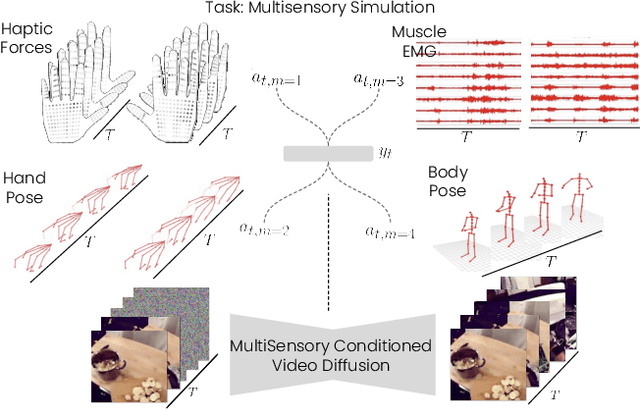
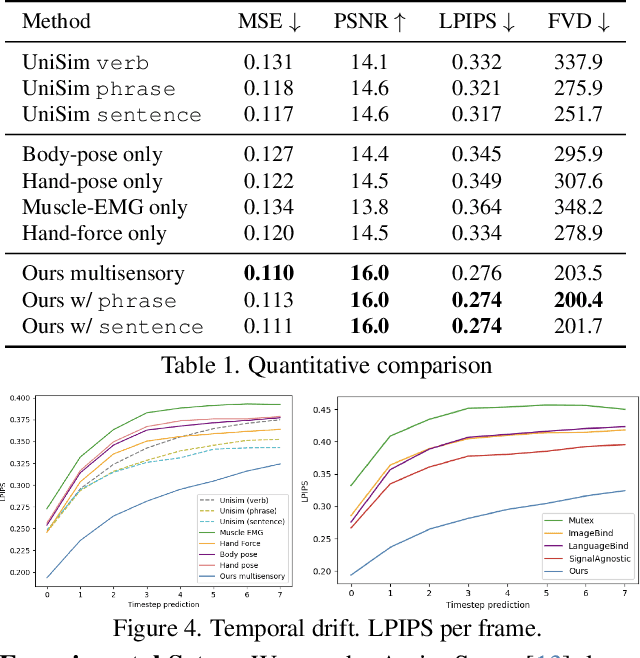
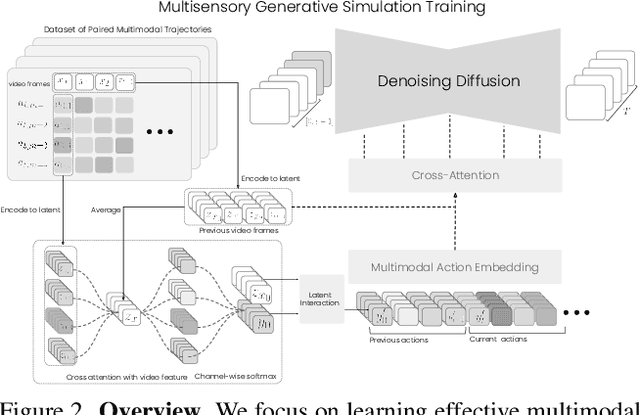
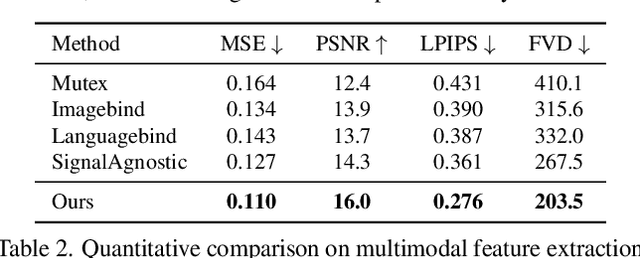
Abstract:Current video models fail as world model as they lack fine-graiend control. General-purpose household robots require real-time fine motor control to handle delicate tasks and urgent situations. In this work, we introduce fine-grained multimodal actions to capture such precise control. We consider senses of proprioception, kinesthesia, force haptics, and muscle activation. Such multimodal senses naturally enables fine-grained interactions that are difficult to simulate with text-conditioned generative models. To effectively simulate fine-grained multisensory actions, we develop a feature learning paradigm that aligns these modalities while preserving the unique information each modality provides. We further propose a regularization scheme to enhance causality of the action trajectory features in representing intricate interaction dynamics. Experiments show that incorporating multimodal senses improves simulation accuracy and reduces temporal drift. Extensive ablation studies and downstream applications demonstrate the effectiveness and practicality of our work.
Single-pass Adaptive Image Tokenization for Minimum Program Search
Jul 10, 2025Abstract:According to Algorithmic Information Theory (AIT) -- Intelligent representations compress data into the shortest possible program that can reconstruct its content, exhibiting low Kolmogorov Complexity (KC). In contrast, most visual representation learning systems use fixed-length representations for all inputs, ignoring variations in complexity or familiarity. Recent adaptive tokenization methods address this by allocating variable-length representations but typically require test-time search over multiple encodings to find the most predictive one. Inspired by Kolmogorov Complexity principles, we propose a single-pass adaptive tokenizer, KARL, which predicts the appropriate number of tokens for an image in a single forward pass, halting once its approximate KC is reached. The token count serves as a proxy for the minimum description length. KARL's training procedure closely resembles the Upside-Down Reinforcement Learning paradigm, as it learns to conditionally predict token halting based on a desired reconstruction quality. KARL matches the performance of recent adaptive tokenizers while operating in a single pass. We present scaling laws for KARL, analyzing the role of encoder/decoder size, continuous vs. discrete tokenization and more. Additionally, we offer a conceptual study drawing an analogy between Adaptive Image Tokenization and Algorithmic Information Theory, examining the predicted image complexity (KC) across axes such as structure vs. noise and in- vs. out-of-distribution familiarity -- revealing alignment with human intuition.
Ambient Diffusion Omni: Training Good Models with Bad Data
Jun 10, 2025Abstract:We show how to use low-quality, synthetic, and out-of-distribution images to improve the quality of a diffusion model. Typically, diffusion models are trained on curated datasets that emerge from highly filtered data pools from the Web and other sources. We show that there is immense value in the lower-quality images that are often discarded. We present Ambient Diffusion Omni, a simple, principled framework to train diffusion models that can extract signal from all available images during training. Our framework exploits two properties of natural images -- spectral power law decay and locality. We first validate our framework by successfully training diffusion models with images synthetically corrupted by Gaussian blur, JPEG compression, and motion blur. We then use our framework to achieve state-of-the-art ImageNet FID, and we show significant improvements in both image quality and diversity for text-to-image generative modeling. The core insight is that noise dampens the initial skew between the desired high-quality distribution and the mixed distribution we actually observe. We provide rigorous theoretical justification for our approach by analyzing the trade-off between learning from biased data versus limited unbiased data across diffusion times.
Score Distillation Sampling for Audio: Source Separation, Synthesis, and Beyond
May 07, 2025Abstract:We introduce Audio-SDS, a generalization of Score Distillation Sampling (SDS) to text-conditioned audio diffusion models. While SDS was initially designed for text-to-3D generation using image diffusion, its core idea of distilling a powerful generative prior into a separate parametric representation extends to the audio domain. Leveraging a single pretrained model, Audio-SDS enables a broad range of tasks without requiring specialized datasets. In particular, we demonstrate how Audio-SDS can guide physically informed impact sound simulations, calibrate FM-synthesis parameters, and perform prompt-specified source separation. Our findings illustrate the versatility of distillation-based methods across modalities and establish a robust foundation for future work using generative priors in audio tasks.
Eval3D: Interpretable and Fine-grained Evaluation for 3D Generation
Apr 25, 2025Abstract:Despite the unprecedented progress in the field of 3D generation, current systems still often fail to produce high-quality 3D assets that are visually appealing and geometrically and semantically consistent across multiple viewpoints. To effectively assess the quality of the generated 3D data, there is a need for a reliable 3D evaluation tool. Unfortunately, existing 3D evaluation metrics often overlook the geometric quality of generated assets or merely rely on black-box multimodal large language models for coarse assessment. In this paper, we introduce Eval3D, a fine-grained, interpretable evaluation tool that can faithfully evaluate the quality of generated 3D assets based on various distinct yet complementary criteria. Our key observation is that many desired properties of 3D generation, such as semantic and geometric consistency, can be effectively captured by measuring the consistency among various foundation models and tools. We thus leverage a diverse set of models and tools as probes to evaluate the inconsistency of generated 3D assets across different aspects. Compared to prior work, Eval3D provides pixel-wise measurement, enables accurate 3D spatial feedback, and aligns more closely with human judgments. We comprehensively evaluate existing 3D generation models using Eval3D and highlight the limitations and challenges of current models.
Multiagent Finetuning: Self Improvement with Diverse Reasoning Chains
Jan 10, 2025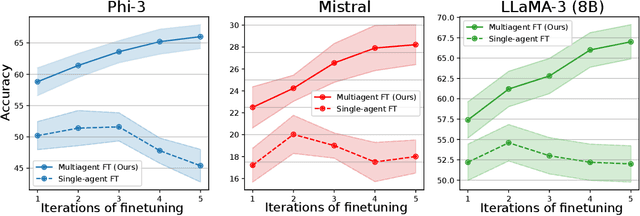
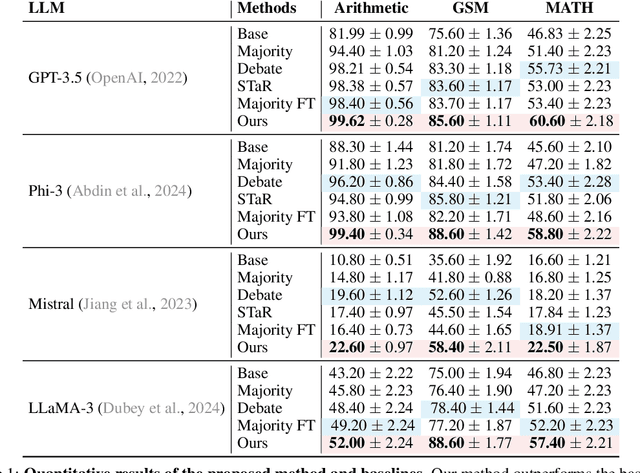
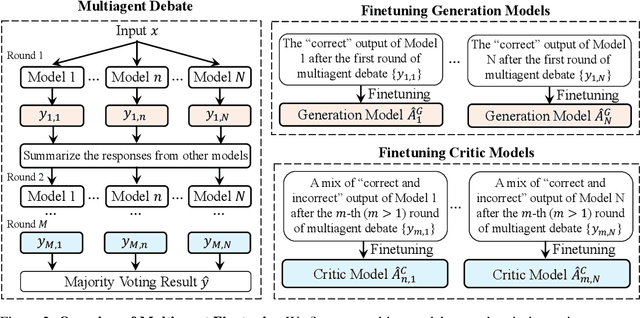
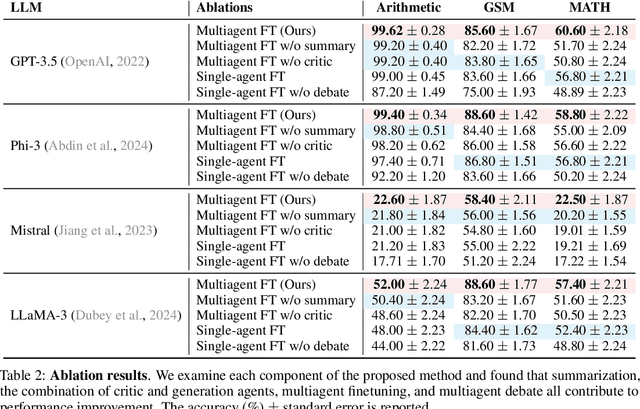
Abstract:Large language models (LLMs) have achieved remarkable performance in recent years but are fundamentally limited by the underlying training data. To improve models beyond the training data, recent works have explored how LLMs can be used to generate synthetic data for autonomous self-improvement. However, successive steps of self-improvement can reach a point of diminishing returns. In this work, we propose a complementary approach towards self-improvement where finetuning is applied to a multiagent society of language models. A group of language models, all starting from the same base model, are independently specialized by updating each one using data generated through multiagent interactions among the models. By training each model on independent sets of data, we illustrate how this approach enables specialization across models and diversification over the set of models. As a result, our overall system is able to preserve diverse reasoning chains and autonomously improve over many more rounds of fine-tuning than single-agent self-improvement methods. We quantitatively illustrate the efficacy of the approach across a wide suite of reasoning tasks.
 Add to Chrome
Add to Chrome Add to Firefox
Add to Firefox Add to Edge
Add to Edge